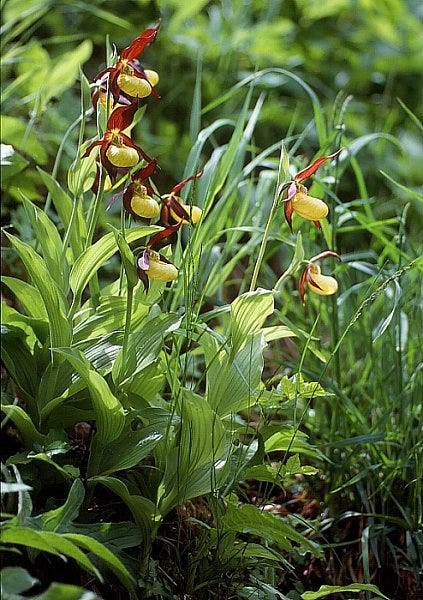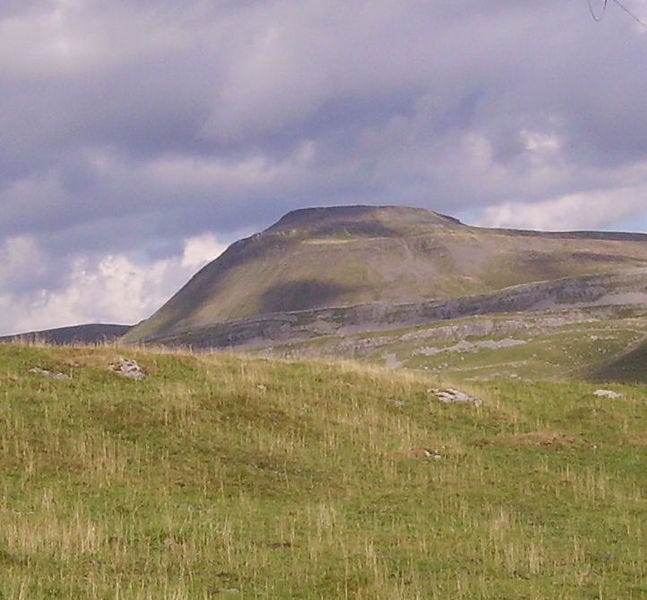Today I’m going to delve into the distant past and write about a particular woman gardener, plant lover and amateur botanist who may be considered “the first recorded woman botanist and plant-collector in England”. She lived at the turn of the 17th century and by the 20th, had attracted the red-hot wrath of one of Britain’s most revered plant hunters, the intrepid Reginald Farrer. It is the story not only of how these two people intersected, but how she also crossed paths with other contemporary botanical heavy-weights and contributed toward their reputation — all the while remaining almost anonymous.

From other researchers, we only know that Thomasin Tunstall was born in Lancashire in the late 1500s, with her active plant hunting years being estimated at between 1620 and 1630. Thomasin would have known the landscape around the Yorkshire Dales intimately; she lived her entire life within a fifty mile radius around Skargill (where she was probably born), “Bull-banke” (where she lived, west of Ingleton and Bentham, near Thurland Castle) and Helkes Wood (where she botanized, just south of Bentham in the Forest of Bowland, adjacent to the Yorkshire Dales).
Despite there being little recorded concerning Tunstall’s birth, family life and death, my ancestry dot com sleuthing found a record of a “Thomasine Tunstall” who was born in 1579 in Skargill, Yorkshire (now Scargill). This was the location of her grandmother’s estate, likely the 12th century Scargill Castle — her grandmother on her father’s side was Mary Alice Scargill (1510-1579), wife to her paternal grandfather, Sir Marmaduke Tunstall (1503-1558)).
Thomasin(e)’s maternal grandmother was Elizabeth Gerard (1520-?). If that last name is familiar to you, it should be because it is the same last name as John Gerard (1545-1612), the famous English botanist and author of Herball, or Generall Historie of Plantes in 1597, published when Thomasine was 18 years old. This association will become most interesting later on….
Her father was Francis Tunstall (1530-1587) and his second wife, Anne Bold (1543-1579) was her mother. Although Thomasine’s birth was at Scargill, her father’s Tunstall family estate was about 50 miles away at Thurland Castle in Lancashire, where multiple generations had lived since the 14th century. That she and her siblings were not born there was probably because Thurland Castle was not claimed by her father until 1585, just two years before he died. Sadly, Thomasin’s mother died the year of her birth and her father not long afterwards, when she was eight years old. We learn more about how Thomasin’s fortunes change around the turn of the 17th century in the 8th volume of the History of the County of Lancaster, Cantsfield Township, published by Victoria County History in London, 1914:
Francis Tunstall (Thomasin’s father) was externally a conformist in religious matters when the Elizabethan changes were made, but being notoriously disaffected (fn. 53) he was brought up for examination in 1568 before the queen's commissioners. He replied that he had usually attended service at Tunstall Church within the past twelve months, but had not received the communion; he had entertained Vaux, the exWarden of Manchester, but had not been aware that the laws forbade it. (fn. 54) In spite of his religious dangers he was able to purchase the manor of Garneygarth in Whittington. He made a settlement of Thurland and other manors in 1585, (fn. 55) and died in or before 1587, leaving a son Francis as heir, but under age, being seventeen years old. (fn. 56) He obtained the inheritance in 1591, (fn. 57) but was involved in a number of disputes and money difficulties, (fn. 58) and about 1605 sold Thurland and the other manors in Tunstall to John Girlington, removing to Scargill in Yorkshire, inherited from his grandmother the wife of Sir Marmaduke. (fn. 59) The new lord of Thurland died in 1612, but was not then seised of any manors or lands in the county. Nicholas, his son and heir, was twenty years of age. (fn. 60)
During the reign of Queen Elizabeth I in the 16th century, the English Parliament passed the Act of Uniformity in 1568. This was an attempt to unify the country by requiring that all citizens attend Anglican church services once weekly and use the English Book of Common Prayer. Citizens who were openly Roman Catholic were at serious risk of being fined, having their property seized, jailed or worse.
Clearly, although Thomasin’s father was “externally a conformist”, that is, passed himself off as Church of England or Anglican, he was “brought up for examination” by the authorities. Sadly, when he died and his son Francis Jr. claimed his inheritance three years later at the age of 20, there were “disputes and money difficulties” — I can’t help but think this was a continuation of the persecution of Roman Catholics, who also happened to be most populous in the northern counties of Lancashire and Yorkshire.
It appears that Thomasin may have also been tagged as a Roman Catholic and was heavily fined some years later in 1629. As a result, she and a person who is likely her sister (Alicia Clopton, nee Tunstall) must pay what is the equivalent of 305.37 pounds sterling per year (or 35 days worth of a skilled tradesman’s wages).
“Little else is known of her background but there is a record in St John’s Parish Church register in the village of Tunstall, dated September 29, 1632, which may relate to her. This lists the marriage between Thomasin Smythies de Tunstall and Thomas Smyth. Also, Farrer & Brownbill (1914; note 59) state that, in 1629, Thomasin Tunstall and Alice Clopton, both of this area, compounded for two thirds of their estates liable to sequestration for recusancy and were each fined £2 10s. a year.”

So, after 1605 and the sale of the family estate, Thurland Castle, Thomasin likely returned to Skargill with her brother, the family home of her paternal grandmother. She was 26 years old. We don’t hear of her again until well into the 1620s and at this time she was living on the edge of the Forest of Bowland at “Bull-banke”. Then in 1632, there is evidence of her marriage at St. John’s parish church in Tunstall to Thomas Smyth, at the age of 53. This seems highly unusual but not impossible.

The more I look into this gentlewoman gardener, the more I find links to my own family history. The area where she lived and plant hunted was in the northern portion of the Forest of Bowland (designated in 1964 as an Area of Outstanding National Beauty - AONB), which was a historic feudal barony (in other words, land that had been granted by the Crown to a baron). My own heritage includes the Townley (or historically, Towneley) family on my mother’s side; they originate in the town of Burnley in Lancashire (due south from Bull-banke across the Forest of Bowland, less than 50 miles away) and are an ancient aristocratic family that dates back one thousand years. The Towneley family purchased the 9000 acres Bowland Forest Estate in 1835 and with it the Lordship of Bowland; it was believed to have passed to the Crown when the land was sold again in 1885, as there was no male heir. But in 2008, it was discovered that the title of Lord had been exempted from the 1885 sale and put for safe-keeping into a Towneley family trust and soon afterwards, Charles Towneley Strachey, 4th Baron O’Hagan (a British conservative politician) unceremoniously sold it. The person who purchased the Lordship of Bowland for a “few thousand pounds” is an anonymous linguistic scientist at Cambridge University, who specializes in Lancashire dialects and place names.
Unbeknowst to me until now, the Towneleys were also “Papists”, and if they had not been so highly positioned, would likely have suffered fines and possibly imprisonment from the mid-16th century until the Roman Catholic Relief Act of 1829.
——————————————————————————————————————
Much of what we know about Thomasin Tunstall we can find in documents from the era — namely John Parkinson’s Paradisi in sole paradisus terrestris. or A garden of all sorts of pleasant flowers which our English ayre will permitt to be noursed vp with a kitchen garden of all manner of herbes, rootes, & fruites, for meate or sause vsed with vs, and an orchard of all sorte of fruitbearing trees and shrubbes fit for our land together with the right orderinge planting & preseruing of them and their vses & vertues collected by Iohn Parkinson apothecary of London, published in 1629.
In it, Parkinson, who was a contemporary of Tunstall but clearly a gentleman of means, is indebted to her for sending him specimens that he happily planted in his own garden and then included in his encyclopedia of England’s native plant life. He writes of three varieties of indigenous terrestrial orchids, all of which have been found by Tunstall and carefully sent along to him at his home in London:
“The first groweth in very many places in Germany, and in other Counitries also. It groweth likewise in Lancashire, neare vpon the border of Yorkeshire, in a wood or place called the Helkes, which is three miles from Ingleborough, the highest hill in England, and not farre from Ingleton, as I am enformed by a courteous Gentlewoman, a great louer of these dellights, called Mistris Thomasin Tunstall, who dwelleth at Bull-banke, neare Hornby Castle in those parts, and who hath often sent mee vp the rootes to London, which haue borne faire flowers in my Garden. The seicond groweth in many places of England, and with the same Gentlewoman also before remembred, who sentme one plant of this kinde with the other.
In Part II, I’ll dive head first into Tunstall’s activities as a plant hunter and plant lover as well as her inglorious mention centuries later in Farrer’s writings.






Great read! Thank you for all the research. Looking forward to Part II.